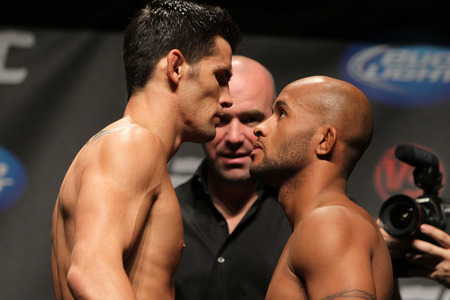
Opinions vary on bantamweight Dominick Cruz's effervescent footwork, mobility and head movement: some feel it's "all show and no go" with fundamental flaws while others laud it as largely innovative. Though much more subtle and deliberate, the supercharged set of wheels that rocket Demetrious Johnson around the Octagon might be his best combat attribute.
If you can tolerate a corny metaphor: I've always likened footwork to the torsional tracks of a tank that are intrinsic in providing the ideal base, balance and position to maximize the violence of the swiveling artillery mounted up top. Achieving the quintessential angle where you are at your strongest and your opponent is at his weakest is the simple function of footwork. The accuracy, power and effectiveness of all strikes are cooperatively amplified by the effectiveness of footwork, just as one's defensive efficacy is directly related to its virtues.
Judo Chop overlord Fraser Coffeen and I have assembled a rundown of the cage characteristics exhibited in past performances by Dominick Cruz and Demetrious Johnson in the full entry.
SBN coverage of UFC on Versus 6: Cruz vs. Johnson
Fraser Coffeen: One of the things I really like about Demetrious Johnson's footwork is his ability to throw strikes while moving and not break his stride. A great example of that came against Damacio Page at WEC 52.
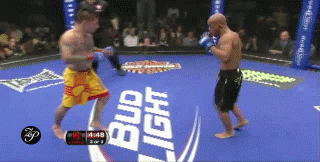
http://2.bp.blogspot.com/_zz3p63WSXZE/TNynJxK6X7I/AAAAAAAAALg/UpTt4xGGPJg/s1600/6.gif
Watch Johnson's attack after Page gets up at the start of the clip. As soon as Damacio regains his feet, Johnson charges forward with a flurry of punches.
As he throws the punches and moves forward, he keeps his feet a good shoulder width apart. But the great moment is when, in the midst of moving forward, he throws a left kick to the body and keeps moving without missing a beat.
This takes some incredible timing. Johnson throws the kick, then brings that left foot down in the lead position. As soon as his foot is down, he takes a small step with the right foot (still keeping the proper distance). As he steps, he throws a punch, and the combination of the kick and punch with their forward momentum are enough to drop Page.
Dallas Winston: Further to Fraser's observations, an excellent indicator of a successful strike or combination is the balance with which it is thrown. We've seen "fast" fighters in MMA but generally the quicker they move and react, the more off balance and out of control they are. That is not the case with Johnson, who accelerates with blinding speed while always maintaining exceptional poise, composure and balance to react on the fly accordingly.
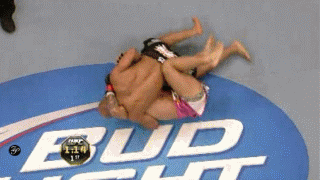
Fraser Coffeen: Here is another example, this time from Johnson's UFC debut against Kid Yamamoto.
Again we see Mighty Mouse able to push forward while throwing knees, punches, and kicks. One of the reasons he can string blows together like this is his total comfort in either the orthodox or south paw stance.
In this sequence, Johnson is in south paw (right leg in front, left leg back) when he comes up from the scramble.
He uses a left knee to switch to orthodox (left leg in front, right back), then after the right high kick, he brings the right foot back down in the lead position, putting himself back in south paw and allowing him to immediately continue attacking with punches.
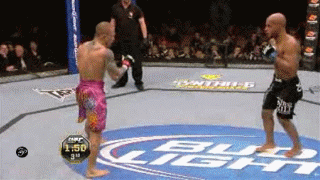 Dallas Winston: To the right is another example from the Yamamoto fight where Johnson's footwork is cerebral and calculating.
Dallas Winston: To the right is another example from the Yamamoto fight where Johnson's footwork is cerebral and calculating.Notice how, after Johnson's initial flurry, he slips on a sidestep when re-engaging and Kid is so locked into reaction mode that he nearly loses his own footing when trying to adjust.
Another subtle factor is how methodically Johnson keeps cutting off angles and steering Kid back into the cage wall. The double leg that concludes the sequence is poetic: it's set up with strikes, his level change is textbook and he gets ultra-deep penetration.
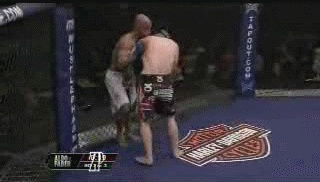
Fraser Coffeen: Switching back and forth so fluidly gives Johnson more options in his combos, and makes his already fast strikes come together even faster.
The biggest time Johnson's footwork failed him was against Brad Pickett in Johnson's lone loss. In that fight, Pickett was able to read Johnson's leg kicks, consistently catching the leg and using it to score takedowns.
Pickett also managed to control the cage positioning at times. Here you see Pickett able to secure a takedown with relative ease thanks to having trapped Johnson against the cage.

Dominick Cruz's footwork is interesting in that there is a lot that is technically "wrong" with what he does. Similar to Rashad Evans, Cruz does things that are usually big problems, but he makes it work with
his style. Here's a great example of that from the Scott Jorgensen fight.
http://1.bp.blogspot.com/_zz3p63WSXZE/TQra_dxlXHI/AAAAAAAAA8g/flbNcaUcHng/s1600/1.gif
At the start of the clip, as Cruz backs away he completely crosses his feet, almost looking to be off balance for a moment, but then uses a hop to get back to an orthodox stance and resumes his attack.
Here's another example of what some call a lack of footwork fundamentals.
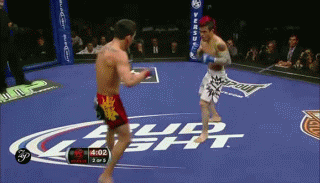
Throughout this sequence, keep an eye on Cruz's feet. He constantly brings them together, giving up the shoulder width stance that you should always maintain. A wider base in your feet gives you more power in your shots, and a greater ability to quickly move away from incoming shots.
When Cruz has his feet together, he needs an extra step to escape. The feet together also forces his body to be more square to his opponent, which makes Cruz an easier target to hit. But Cruz uses distance and head movement so well that he doesn't get hit in these moments.
Dallas Winston: What I respect about Cruz's head movement and footwork is that it's unpredictable. Even though certain consistencies and repetition can be tracked, his degree of angle and distance of travel are fairly drastic compared to the norm.

In the clip above, check out the extreme difference in the hard circle he cuts to his back-left compared to the ground he covers going straight forward with the low kick and left hand.
When trying to get a bead on his motion, your target switches in enormous increments from drifting backward and out of the pocket several feet back to charging straight forward with stiff strikes in your face.
This ploy of motion and direction is also what enables Cruz to catch Jorgensen on his heels by springing forward aggressively after a number of circular and less volatile retreats backward.
Fraser Coffeen: Cruz does also use more traditional footwork very effectively at times. In the above sequence he does a great job using footwork to position Jorgensen where he wants him and secure the takedown.
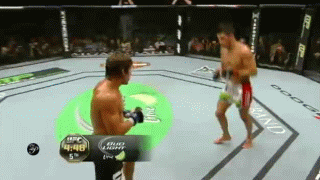
At the start, Jorgensen is moving to his right and Cruz is following.
Cruz takes a quick hop step in that direction, getting ahead of Jorgensen and cutting him off. At the same time, Cruz throws a left hook. Jorgensen responds by changing directions and moving left, which is exactly what Cruz anticipated. Cruz drops down and uses Jorgensen's momentum to the left to get the takedown.
That hop step or hop switch is one of Cruz's best tools in his footwork. In the above clip, we saw him use that hop to quickly cut Jorgensen off. He also uses it to quickly get inside his opponent's range, or to get himself back to orthodox stance, as we saw in the first Jorgensen clip.
Above is another example of Cruz using the hop to get back to orthodox (against Urijah Faber), then immediately attacking with a jumping knee.
While Cruz is comfortable in either stance, when he has separation, he will often use that hop to reset to orthodox before beginning his attack, and frequently will begin attacking immediately after the switch.
 Against Faber, we saw some good examples of Cruz's footwork being figured out. Here's one example of Cruz trying to use that same hop to the outside that he did against Jorgensen:
Against Faber, we saw some good examples of Cruz's footwork being figured out. Here's one example of Cruz trying to use that same hop to the outside that he did against Jorgensen:Faber responds with an outside leg kick, which immediately stops Cruz's momentum. Cruz resets, but he's sloppy when he comes back inside - notice the hesitation in his feet as he moves back in after the kick. Without that crisp movement, Cruz leaves himself open, and Faber is able to follow up with a nice right hand that staggers the champion.
Dallas Winston: My last observation was how Cruz unleashes a surprise attack with sudden forward movement after dawdling backward to lullaby his opponent, but here we see Faber employ that strategy to catch him off-guard.
Quite consistently in the Faber fight, Cruz was tagged with a simple and straight punch while bouncing around on the perimeter and trying to find his rhythm. His overall activity and level of motion is extremely high and sometimes he's overly fixated on it.
It was no coincidence that Cruz scored his best shots when he was leading exchanges and quickly pivoting at a unique chain of add angles, and Faber countered most effectively when he didn't let Cruz mesmerize him with a sequence of clever set ups.


